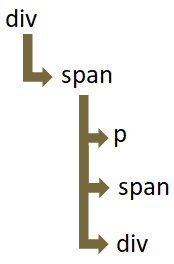

Not just parent - child relationship, but JQuery also provides effective methods to deal with siblings. And which all elements are siblings?
Let us see in the below example,
<html>
<head>
<title> My First Programme </title>
</head>
<body>
<h1> JQuery </h1>
<div>
<span>
<p> This is Sibling one </p>
<span> This is Sibling two </span>
<div> This is Sibling three </div>
</span>
</div>
<button> Click Me </button>
<script src = "https://cdnjs.cloudflare.com/ajax/libs/JQUERY/3.3.1/jquery.min.js"> </script>
<script>
$('button').click(function(){
$("p").siblings().css({"color": "blue"});
});
</script>
</body>
</html>
In the above example, we have the <div> element. And the <div> element has a child <span>, and the <span> element has three children i.e. <p>, <span> and <div>.
<div> <span> <p> This is Sibling one </p> <span> This is Sibling two </span> <div> This is Sibling three </div> </span> </div>
Now, let us see the below structure,

So, just like a normal family hierarchy, the <span> element has three children i.e. <p>, <span> and <div>.
So, <p>, <span> and <div> are siblings.
And the siblings() method changes the color of <span> and <div> elements. Since, <span> and <div> elements are siblings of <p>.
$('button').click(function(){
$("p").siblings().css({"color": "blue"});
});Similarly, there are other methods that helps us find the siblings. Let us see them below,
The next() method gives us the next sibling of the specified element.
<html>
<head>
<title> My First Programme </title>
</head>
<body>
<h1> JQuery </h1>
<div>
<span>
<p> This is Sibling one </p>
<span> This is Sibling two </span>
<div> This is Sibling three </div>
</span>
</div>
<button> Click Me </button>
<script src = "https://cdnjs.cloudflare.com/ajax/libs/JQUERY/3.3.1/jquery.min.js"> </script>
<script>
$('button').click(function(){
$("p").next().css({"color": "blue"});
});
</script>
</body>
</html>
In the above example, we have the <div> element. And the <div> element has a child <span>, and the <span> element has three children i.e. <p>, <span> and <div>.
<div> <span> <p> This is Sibling one </p> <span> This is Sibling two </span> <div> This is Sibling three </div> </span> </div>
Now, let us see the below structure,

So, the <span> element has three children i.e. <p>, <span> and <div>.
And the next() method changes the color of <span> element only. Since, <span> is the next sibling of <p>.
$('button').click(function(){
$("p").next().css({"color": "blue"});
});The next() method gives us all the next sibling of the specified element.
<html>
<head>
<title> My First Programme </title>
</head>
<body>
<h1> JQuery </h1>
<div>
<span>
<p> This is Sibling one </p>
<span> This is Sibling two </span>
<div> This is Sibling three </div>
</span>
</div>
<button> Click Me </button>
<script src = "https://cdnjs.cloudflare.com/ajax/libs/JQUERY/3.3.1/jquery.min.js"> </script>
<script>
$('button').click(function(){
$("p").nextAll().css({"color": "blue"});
});
</script>
</body>
</html>
In the above example, we have the <div> element. And the <div> element has a child <span>, and the <span> element has three children i.e. <p>, <span> and <div>.
<div> <span> <p> This is Sibling one </p> <span> This is Sibling two </span> <div> This is Sibling three </div> </span> </div>
Now, let us see the below structure,

So, the <span> element has three children i.e. <p>, <span> and <div>.
And the nextAll() method changes the color of <span> and <div> element. Since, nextAll() methods selects all the siblings next to <p>.
$('button').click(function(){
$("p").nextAll().css({"color": "blue"});
});The nextUntil() method gives us all the next siblings until a specified element.
<html>
<head>
<title> My First Programme </title>
</head>
<body>
<h1> JQuery </h1>
<div>
<span>
<p> This is Sibling one </p>
<span> This is Sibling two </span>
<div> This is Sibling three </div>
</span>
</div>
<button> Click Me </button>
<script src = "https://cdnjs.cloudflare.com/ajax/libs/JQUERY/3.3.1/jquery.min.js"> </script>
<script>
$('button').click(function(){
$("p").nextUntil("div").css({"color": "blue"});
});
</script>
</body>
</html>
In the above example, we have the <div> element. And the <div> element has a child <span>, and the <span> element has three children i.e. <p>, <span> and <div>.
<div> <span> <p> This is Sibling one </p> <span> This is Sibling two </span> <div> This is Sibling three </div> </span> </div>
Now, let us see the below structure,

So, the <span> element has three children i.e. <p>, <span> and <div>.
And the nextUntil() method changes only the color of <span> element.
$('button').click(function(){
$("p").nextUntil("div").css({"color": "blue"});
});The prev() method gives us the previous sibling of the specified element.
<html>
<head>
<title> My First Programme </title>
</head>
<body>
<h1> JQuery </h1>
<div>
<span>
<p> This is Sibling one </p>
<span> This is Sibling two </span>
<div> This is Sibling three </div>
</span>
</div>
<button> Click Me </button>
<script src = "https://cdnjs.cloudflare.com/ajax/libs/JQUERY/3.3.1/jquery.min.js"> </script>
<script>
$('button').click(function(){
$("div").prev().css({"color": "blue"});
});
</script>
</body>
</html>
The prevAll() method gives us all the previous sibling of the specified element.
<html>
<head>
<title> My First Programme </title>
</head>
<body>
<h1> JQuery </h1>
<div>
<span>
<p> This is Sibling one </p>
<span> This is Sibling two </span>
<div> This is Sibling three </div>
</span>
</div>
<button> Click Me </button>
<script src = "https://cdnjs.cloudflare.com/ajax/libs/JQUERY/3.3.1/jquery.min.js"> </script>
<script>
$('button').click(function(){
$("p").prevAll().css({"color": "blue"});
});
</script>
</body>
</html>
The prevUntil() method gives us all the previous siblings until a specified element.
<html>
<head>
<title> My First Programme </title>
</head>
<body>
<h1> JQuery </h1>
<div>
<span>
<p> This is Sibling one </p>
<span> This is Sibling two </span>
<div> This is Sibling three </div>
</span>
</div>
<button> Click Me </button>
<script src = "https://cdnjs.cloudflare.com/ajax/libs/JQUERY/3.3.1/jquery.min.js"> </script>
<script>
$('button').click(function(){
$("p").nextUntil("div").css({"color": "blue"});
});
</script>
</body>
</html>